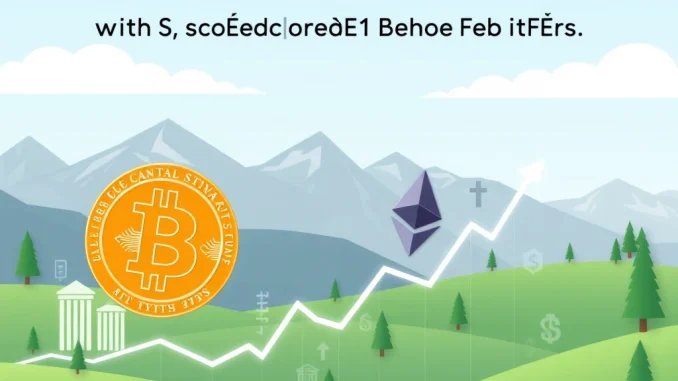
The world of digital asset investment is seeing significant momentum, particularly within regulated products. Recent data highlights a surge in capital flowing into US spot Bitcoin ETFs, indicating growing interest from both institutional and retail investors seeking exposure to the cryptocurrency market through traditional investment vehicles. These inflows provide a clear signal about current market sentiment and the increasing acceptance of digital assets.
Massive Capital Enters US Spot Bitcoin ETFs
According to data tracked by SoSoValue, US spot Bitcoin ETFs recorded a substantial combined net inflow of $2.22 billion during the last week. This figure underscores robust demand for the leading cryptocurrency via these accessible investment products since their launch earlier this year. The consistent positive flows into these funds are often interpreted as a bullish indicator, reflecting investor confidence and potentially influencing market dynamics.
Since their debut in January, these ETFs have become a popular conduit for investors previously hesitant to directly hold Bitcoin. They offer regulatory clarity, ease of trading on traditional exchanges, and integration into existing investment portfolios. The $2.22 billion inflow in just one week demonstrates the significant scale of capital deployment occurring through these regulated pathways.
Key takeaways from the recent Bitcoin ETF inflows:
- A combined net inflow of $2.22 billion was recorded last week.
- This highlights sustained investor interest in gaining Bitcoin exposure via traditional finance.
- The inflows contribute to validating Bitcoin as an investable asset class.
- Various funds contributed to this total, reflecting broad market participation.
Comparing Bitcoin and Ethereum ETF Inflows
While Bitcoin ETFs dominated the headlines, Ethereum ETF inflows also registered positive numbers last week. SoSoValue data shows that U.S. spot Ethereum (ETH) ETFs saw net inflows totaling $283.41 million over the same seven-day period. Although significantly less than Bitcoin’s figure, this still represents a notable amount of capital entering the second-largest cryptocurrency via ETFs.
The difference in inflow amounts between Bitcoin and Ethereum ETFs is understandable given several factors:
- Launch Timing: US spot Bitcoin ETFs launched in January 2024, gaining a head start in attracting capital and establishing trading history. US spot Ethereum ETFs were approved and launched more recently, meaning they are still in the early stages of capital accumulation.
- Market Maturity & Awareness: Bitcoin has a longer history and higher public recognition than Ethereum, potentially leading to broader investor familiarity and comfort.
- Regulatory Clarity: While both now have spot ETFs, the regulatory path and classification of Bitcoin have historically been viewed with slightly more clarity by some traditional finance participants compared to Ethereum.
Despite the disparity, the positive flows into both asset classes signal increasing investor appetite for regulated digital asset exposure beyond just Bitcoin. The nearly $300 million into Ethereum ETFs in a single week suggests growing confidence in ETH’s potential and the utility of its underlying blockchain.
What These Inflows Mean for the Crypto ETF Market
The combined inflows into US spot Bitcoin ETFs and Ethereum ETFs last week paint a clear picture: the Crypto ETF market is a rapidly maturing segment attracting substantial investment. These products are successfully bridging the gap between traditional finance and the digital asset space, offering a regulated and familiar entry point for investors.
The consistent positive flows into these ETFs demonstrate:
- Growing Institutional Adoption: Large inflows often indicate participation from institutional players like hedge funds, asset managers, and financial advisors allocating client capital.
- Increased Accessibility: ETFs make it easier for retail investors to add crypto exposure to their brokerage accounts without dealing with private keys or crypto exchanges.
- Validation of Digital Assets: Strong demand for these products validates Bitcoin and Ethereum as legitimate asset classes for investment portfolios.
However, it’s also important to consider potential implications:
While inflows are positive, they can also contribute to market volatility. Large purchases by ETFs can influence price, and conversely, significant outflows could exert downward pressure. The concentration of assets within a few large ETFs also presents a point of centralization risk within the broader digital asset ecosystem.
The Future of Digital Asset ETFs
The success of US spot Bitcoin ETFs and the promising start for Ethereum ETFs suggest a positive trajectory for Digital asset ETFs. The demand seen so far could pave the way for ETFs tracking other cryptocurrencies or baskets of digital assets, further expanding the ways investors can access this market through regulated products.
As the market evolves, investors should continue to monitor inflow and outflow data from these ETFs as a potential indicator of market sentiment and capital flows. While these figures provide valuable insight, they are just one piece of the complex puzzle that is the digital asset market.
Actionable Insight: Investors considering exposure to digital assets via ETFs should look at the long-term trends of inflows and outflows, understand the fees associated with different funds, and consider how these products fit within their overall investment strategy and risk tolerance.
Summary: Capital Continues to Flow
Last week’s data from SoSoValue confirms robust investor interest in regulated digital asset products. US spot Bitcoin ETFs attracted a significant $2.22 billion in net inflows, reinforcing their role as a major gateway for capital into the Bitcoin market. U.S. spot Ethereum ETFs also saw positive inflows of $283.41 million, signaling growing appetite for ETH exposure. These figures highlight the increasing maturation of the Crypto ETF market and the continued integration of Digital asset ETFs into the mainstream investment landscape. While inflows are positive, investors should remain informed about market dynamics and conduct their own research.



